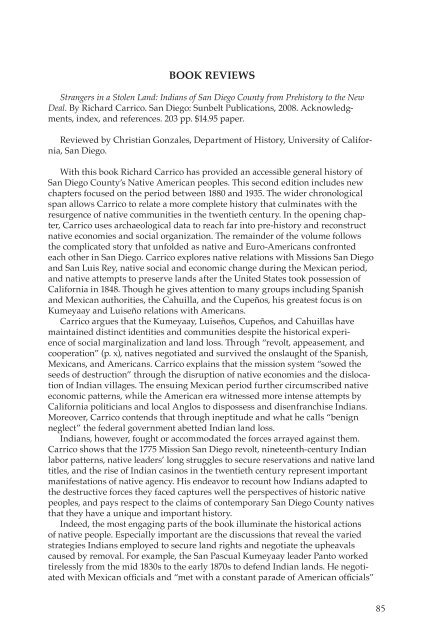You also want an ePaper? Increase the reach of your titles
YUMPU automatically turns print PDFs into web optimized ePapers that Google loves.
BOOK REVIEWS<br />
Strangers in a Stolen Land: Indians of <strong>San</strong> <strong>Diego</strong> County from Prehistory to the New<br />
Deal. By Richard Carrico. <strong>San</strong> <strong>Diego</strong>: Sunbelt Publications, 2008. Acknowledgments,<br />
index, and references. 203 pp. $14.95 paper.<br />
Reviewed by Christian Gonzales, Department of <strong>History</strong>, University of California,<br />
<strong>San</strong> <strong>Diego</strong>.<br />
With this book Richard Carrico has provided an accessible general history of<br />
<strong>San</strong> <strong>Diego</strong> County’s Native American peoples. This second edition includes new<br />
chapters focused on the period between 1880 and 1935. The wider chronological<br />
span allows Carrico to relate a more complete history that culminates with the<br />
resurgence of native communities in the twentieth century. In the opening chapter,<br />
Carrico uses archaeological data to reach far into pre-history and reconstruct<br />
native economies and social organization. The remainder of the volume follows<br />
the complicated story that unfolded as native and Euro-Americans confronted<br />
each other in <strong>San</strong> <strong>Diego</strong>. Carrico explores native relations with Missions <strong>San</strong> <strong>Diego</strong><br />
and <strong>San</strong> Luis Rey, native social and economic change during the Mexican period,<br />
and native attempts to preserve lands after the United States took possession of<br />
California in 1848. Though he gives attention to many groups including Spanish<br />
and Mexican authorities, the Cahuilla, and the Cupeños, his greatest focus is on<br />
Kumeyaay and Luiseño relations with Americans.<br />
Carrico argues that the Kumeyaay, Luiseños, Cupeños, and Cahuillas have<br />
maintained distinct identities and communities despite the historical experience<br />
of social marginalization and land loss. Through “revolt, appeasement, and<br />
cooperation” (p. x), natives negotiated and survived the onslaught of the Spanish,<br />
Mexicans, and Americans. Carrico explains that the mission system “sowed the<br />
seeds of destruction” through the disruption of native economies and the dislocation<br />
of Indian villages. The ensuing Mexican period further circumscribed native<br />
economic patterns, while the American era witnessed more intense attempts by<br />
California politicians and local Anglos to dispossess and disenfranchise Indians.<br />
Moreover, Carrico contends that through ineptitude and what he calls “benign<br />
neglect” the federal government abetted Indian land loss.<br />
Indians, however, fought or accommodated the forces arrayed against them.<br />
Carrico shows that the 1775 Mission <strong>San</strong> <strong>Diego</strong> revolt, nineteenth-century Indian<br />
labor patterns, native leaders’ long struggles to secure reservations and native land<br />
titles, and the rise of Indian casinos in the twentieth century represent important<br />
manifestations of native agency. His endeavor to recount how Indians adapted to<br />
the destructive forces they faced captures well the perspectives of historic native<br />
peoples, and pays respect to the claims of contemporary <strong>San</strong> <strong>Diego</strong> County natives<br />
that they have a unique and important history.<br />
Indeed, the most engaging parts of the book illuminate the historical actions<br />
of native people. Especially important are the discussions that reveal the varied<br />
strategies Indians employed to secure land rights and negotiate the upheavals<br />
caused by removal. For example, the <strong>San</strong> Pascual Kumeyaay leader Panto worked<br />
tirelessly from the mid 1830s to the early 1870s to defend Indian lands. He negotiated<br />
with Mexican officials and “met with a constant parade of American officials”<br />
85







![[PDF] The Journal of San Diego History Vol 52: Nos 1 & 2](https://img.yumpu.com/25984149/1/172x260/pdf-the-journal-of-san-diego-history-vol-52-nos-1-2.jpg?quality=85)

![[PDF] The Journal of San Diego History - San Diego History Center](https://img.yumpu.com/25984131/1/172x260/pdf-the-journal-of-san-diego-history-san-diego-history-center.jpg?quality=85)






